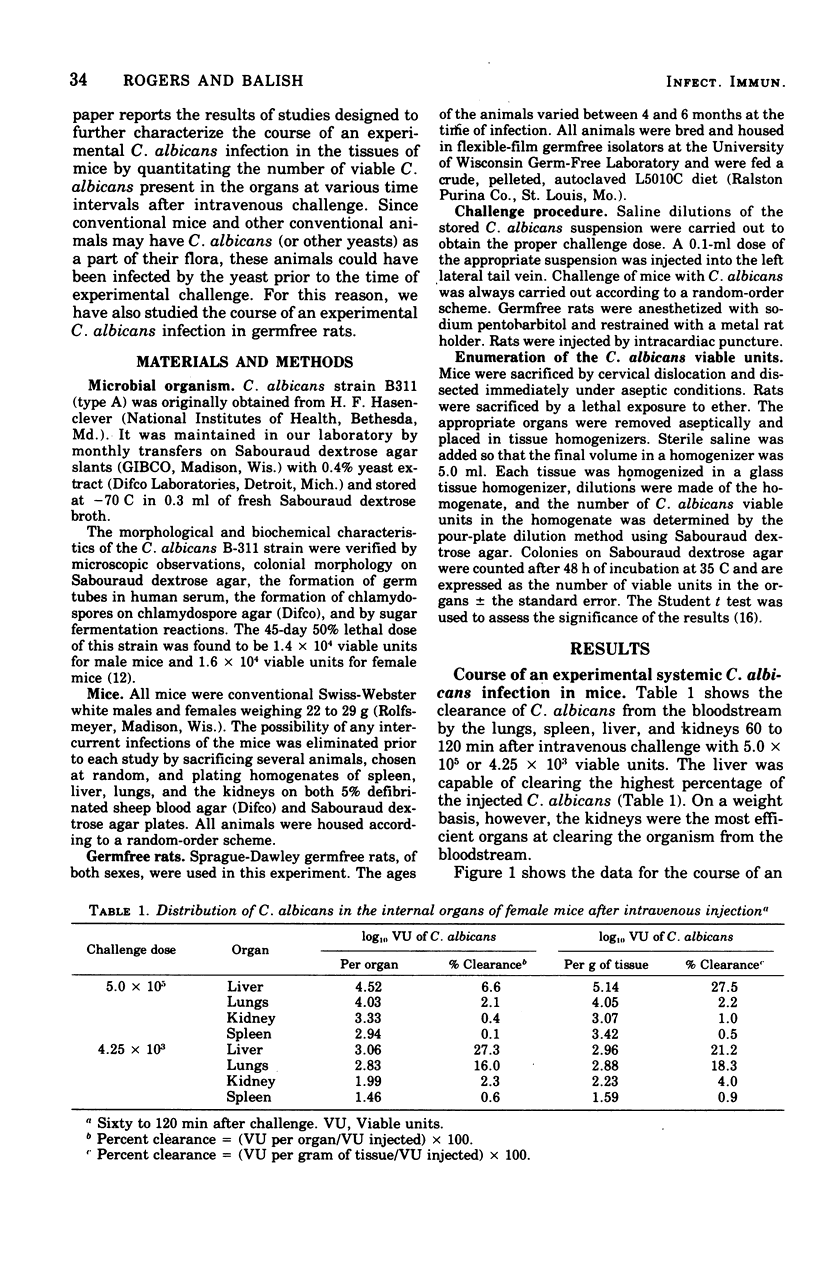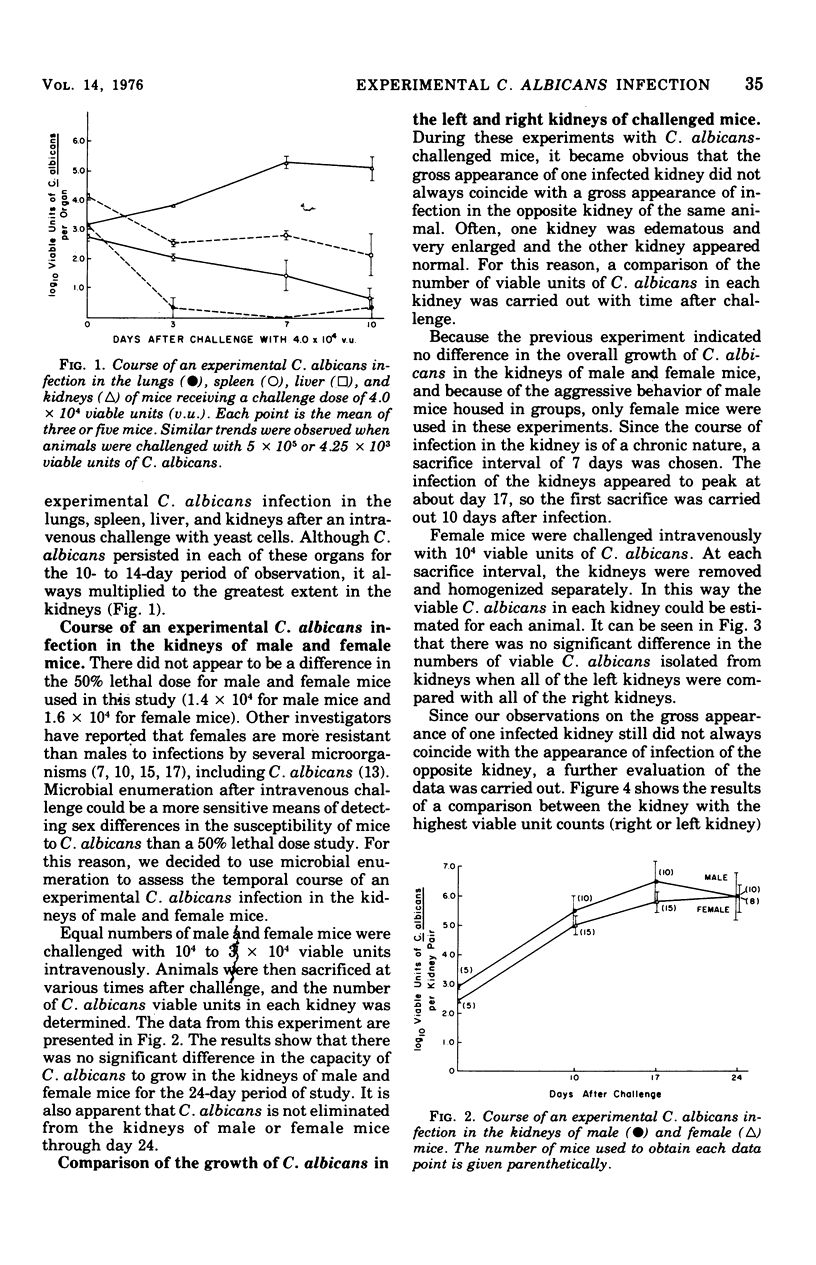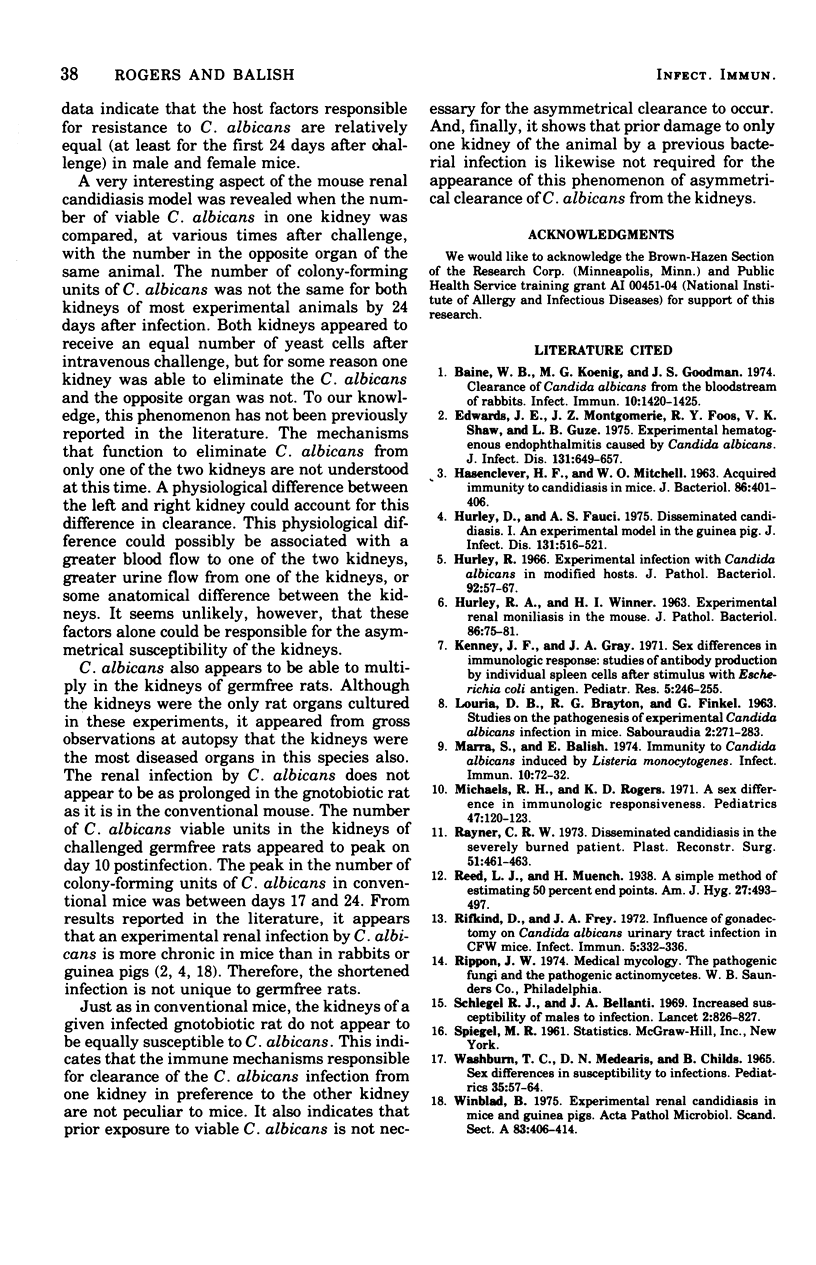Abstract
Swiss-Webster white mice were intravenously infected with various doses of Candida albicans, and the viable units in their spleens, livers, lungs, and kidneys were determined at various intervals after challenge. The results showed that C. albicans multiplied to a greater extent in the kidneys of mice than in their spleens, lungs, or livers. The infection in mice was chronic; increasing numbers of C. albicans were observed in their kidneys until about 17 to 24 days postchallenge. Clearance of C. albicans from infected kidneys was not symmetrical, since the number of viable C. albicans in one kidney did not coincide with the viable counts observed in the opposite kidney of that same animal. Male and female mice did not differ in their overall susceptibility (50% lethal dose test) or in the number of viable C. albicans in the kidneys at various time intervals after infection. C. albicans also multiplied in the kidneys of germfree rats; however, the peak of the C. albicans infection in their kidneys occurred earlier than in those of conventional mice.
Full text
PDF





Selected References
These references are in PubMed. This may not be the complete list of references from this article.
- Baine W. B., Koenig M. G., Goodman J. S. Clearance of Candida albicans from the bloodstream of rabbits. Infect Immun. 1974 Dec;10(6):1420–1425. doi: 10.1128/iai.10.6.1420-1425.1974. [DOI] [PMC free article] [PubMed] [Google Scholar]
- Edwards J. E., Jr, Montgomerie J. Z., Foos R. Y., Shaw V. K., Guze L. B. Experimental hematogenous endophthalmitis caused by Candida albicans. J Infect Dis. 1975 Jun;131(6):649–657. doi: 10.1093/infdis/131.6.649. [DOI] [PubMed] [Google Scholar]
- HASENCLEVER H. F., MITCHELL W. O. ACQUIRED IMMUNITY TO CANDIDIASIS IN MICE. J Bacteriol. 1963 Sep;86:401–406. doi: 10.1128/jb.86.3.401-406.1963. [DOI] [PMC free article] [PubMed] [Google Scholar]
- HURLEY R., WINNER H. I. Experimental renal moniliasis in the mouse. J Pathol Bacteriol. 1963 Jul;86:75–82. doi: 10.1002/path.1700860109. [DOI] [PubMed] [Google Scholar]
- Hurley D. L., Fauci A. S. Disseminated candidiasis. i. an experimental model in the guinea pig. J Infect Dis. 1975 May;131(5):516–527. doi: 10.1093/infdis/131.5.516. [DOI] [PubMed] [Google Scholar]
- Hurley R. Experimental infection with Candida albicans in modified hosts. J Pathol Bacteriol. 1966 Jul;92(1):57–67. doi: 10.1002/path.1700920108. [DOI] [PubMed] [Google Scholar]
- Marra S., Balish E. Immunity to Candida albicans induced by Listeria monocytogenes. Infect Immun. 1974 Jul;10(1):72–82. doi: 10.1128/iai.10.1.72-82.1974. [DOI] [PMC free article] [PubMed] [Google Scholar]
- Michaels R. M., Rogers K. D. A sex difference in immunologic responsiveness. Pediatrics. 1971 Jan;47(1):120–123. [PubMed] [Google Scholar]
- Rayner C. R. Disseminated candidiasis in a severely burned patient. Case report. Plast Reconstr Surg. 1973 Apr;51(4):461–463. doi: 10.1097/00006534-197304000-00027. [DOI] [PubMed] [Google Scholar]
- Rifkind D., Frey J. A. Influence of gonadectomy on Candida albicans urinary tract infection in CFW mice. Infect Immun. 1972 Mar;5(3):332–336. doi: 10.1128/iai.5.3.332-336.1972. [DOI] [PMC free article] [PubMed] [Google Scholar]
- Schlegel R. J., Bellanti J. A. Increased susceptibility of males to infection. Lancet. 1969 Oct 18;2(7625):826–827. doi: 10.1016/s0140-6736(69)92278-8. [DOI] [PubMed] [Google Scholar]
- WASHBURN T. C., MEDEARIS D. N., Jr, CHILDS B. SEX DIFFERENCES IN SUSCEPTIBILITY TO INFECTIONS. Pediatrics. 1965 Jan;35:57–64. [PubMed] [Google Scholar]
- Winblad B. Experimental renal candidiasis in mice and guinea pigs. Acta Pathol Microbiol Scand A. 1975 Jul;83(4):406–414. doi: 10.1111/j.1699-0463.1975.tb01890.x. [DOI] [PubMed] [Google Scholar]


